 |
Maehler & Kaege locking Garage socket and plug |
non- standard |
classic plugs |
direct current |
| The Elektrotechnische Spezialfabrik
founded by Hugo Maehler and Wilhelm Kaege in 1907 in Ingelheim am Rhein
has development a large range of electrical accessories that could be
used safely in spaces with an enhanced risk of fire or explosion due
to flammable fumes. Arc
flashes may occur when equipment is unplugged or switched off; contact
with combustible material has to be avoided. Flammable fumes could be present garages for repair or storage of motor vehicles. That explains the name Garage Steckdose und Stecker for the socket and plug shown below. |
 |
 |
 |
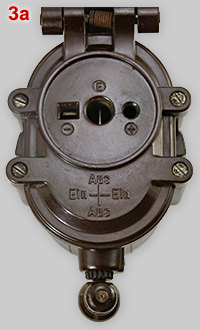 |
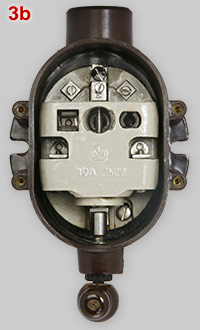 |
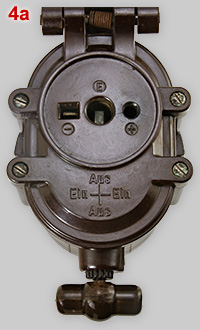 |
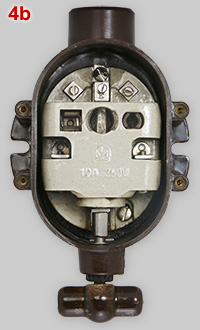 |
| 1 - 2 |
Maehler
& Kaege socket and plug, rated at 10A - 250V. The indication of +
and -, rather than L and N suggests that primarily the device is meant
for direct current*. The plug is polarized because of different pin
shapes. The earth pin (E) has a groove that allows, in combination with a turnable rod in the socket, to lock the plug. See images 3 and 4, and scheme 5 for details. A locked plug prevent unintentional disconnection of the appliance. Depending on the situation, other precautionary measures have to be taken first. Maehler & Kaege have outsourced Bakelite cast production to Wolff & Co. in Walsrode, Niedersachsen (MPAD mark 33-S). Another, fully identical socket in the museum collection has been nade by Gebrüder Spindler KG in Köppelsdorf, Stadt Sonneberg, Thüringen (MPAD mark E7-S). Dating of the 10A Garage socket and plug: 1930s. * Arc formation occurs both in direct and alternating current, but it is more prominent in DC then AC. This may explain the relative low rating: 10A (DC). Plug pins and socket contacts have dimensions that would allow 16 - 20A AC. |
| 3a- b 4a-b |
The large,
turnable knob is a prominent socket feature. A ca. 7 cm long rod is
fixed to the knob. The metal rod is ca. 2 mm thick (visible in images
3a,b) and after 90 knob rotation ca. 6 mm wide (visible in mages 4a, b). The function of the rod is shown in figure 5. |
| 5 | Procedure
to insert Maehler & Kaege plug No. 2 into socket No. 1. The crucial element are: (i) Bakelite knob with metal rod (red), (ii) plug earth pin and (iii) socket earth contact. Step 1: turn knob in vertical position, which corresponds to Aus position as indicated on the socket (images 3a,b). Steps 2-4: push plug down until the earch pin touches the base of the socket earth contact (=4). Step 5: turn knob 90 degrees (images 4a,b), which corresponds to Ein position. The bar locks the earth pin and seures the plug. To retract the plug: turn the knob to Aus position. Note that even in an unlocked position (step 4), the earth pin is fully functional. |
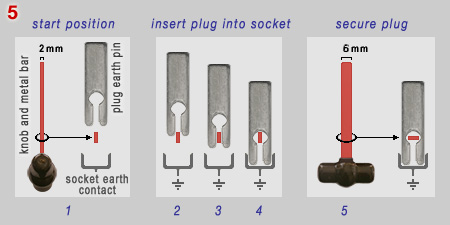 |
 |
| 6 | A 6A version of the Maehler & Kaege garage plug and
socket was also available. The illustration, taken from a 1929
catalog*, shows that the 6A version was nearly identical to the 10A
model. The only meaningful differende refers to the shape of the minus
pin: rectangular for 6A (see socket), while rectangular of 10A (see
image nos, 3 and 4). This would mean that 10A plugs do not fit in a
6A socket. * provided by Reiner Hahn. |
| More examples of
locking plugs are shown in the museum; click here for an overview. |
| |
D i g i t a l M u s e u m o f | |
P l u g s a n d S o c k e t s | |